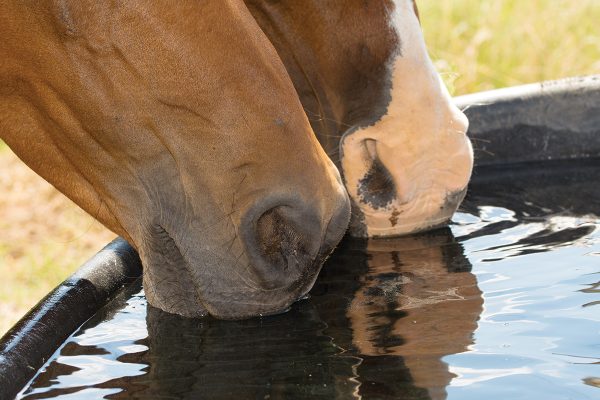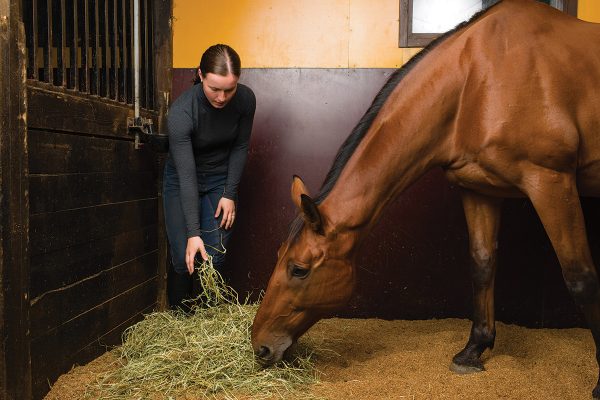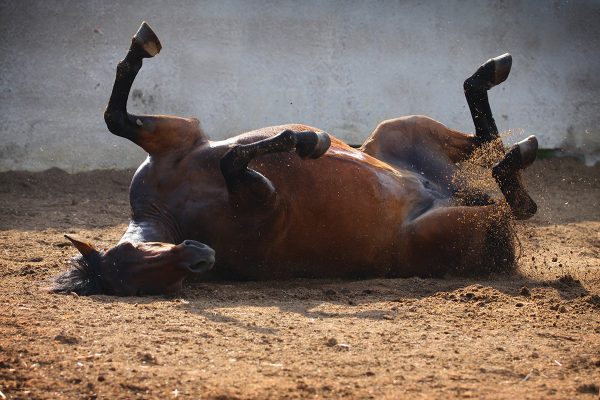You may have heard the term “colic” before, but what is it? Colic refers to pain in a horse’s abdomen. Basically, it’s an equine belly ache. Because of a horse’s complex digestive system and the fact that they can’t vomit, any source of pain in a horse’s abdomen can be serious.
Let’s take a closer look at this condition so you’ll know how to recognize the early signs and take quick action to help your horse.
Causes of Colic in Horses
Horses can have abdominal pain for a variety of reasons. One common cause of colic is when digested feed becomes stuck in the intestine. This is called an impaction, and usually happens when a horse doesn’t drink enough water.

When digested feed doesn’t move through the gut fast enough, it starts to put pressure on the intestines and makes the horse uncomfortable. Sometimes a large chunk of feed gets completely stuck in the gut and creates a backup or blockage in the digestive system, which can be very serious.
Another common cause of colic is gas. Sometimes, a horse may have sharp, abdominal gas pains due to a sudden change in diet or routine.

Cancer can also be a cause of colic. Occasionally an older horse will develop a tumor that grows within the gut and becomes tangled around the digestive track, cutting off blood supply to a portion of the intestine.
Stomach ulcers and intestinal parasites may also make a horse uncomfortable enough to exhibit colic signs.
Colic Signs to Watch For
There are a few classic signs of colic that every horse owner should know. One of the earliest signs is a horse that suddenly won’t eat. If your horse normally acts as if he’s starving at meal time and then suddenly has no interest in his food, be alert that something more serious might be going on.
The next sign of colic is restlessness. A horse starting to colic will paw the ground and look at his sides. Some horses will splash around in their water bucket without drinking. With these behaviors, your horse is telling you something hurts and he’s not sure how to make it go away.
As the pain gets worse, the horse will repeatedly lie down and roll. Horses sometimes will do this quickly and violently and may hurt themselves in the process.

As a horse gets tired, he may then become quiet or act lethargic. Often, a horse with colic will be sweaty or may tremble. Typically, a horse with colic hasn’t passed manure recently. If your horse is stalled, look for fresh manure. If you don’t find any, this is a key sign that something is wrong.
What to Do
If you think your horse might have colic based on showing some of the signs mentioned above, watch him closely and monitor his behavior. When was the last time he ate or drank? Does he currently have interest in food? When is the last time you saw him pass manure? Was the manure a normal amount and normal consistency, or was it small and dry? Based on these answers, call your veterinarian and describe what you’ve seen.
While waiting for the vet to arrive, if your horse is restless, hand-walk him in a quiet and safe location. If he doesn’t want to walk or is quiet, place him in a clean stall with access to fresh water but no food—this way, you can monitor for any manure.
When the vet arrives, she will do a full examination and sedate your horse. She will likely then give the horse IV (intravenous) fluids and pain medication. Many times, that’s all it takes to cure a case of colic.
However, sometimes a colic case can’t be solved at the farm and requires special surgery. This happens when the intestine is severely impacted (blocked/backed up) or when a section of the intestines is twisted. Your veterinarian will recommend surgery if the horse is in extreme pain and not responding to pain medication.
How to Prevent Colic in Horses
To help prevent colic, always make sure your horse has access to plenty of fresh, clean water. This is especially important in the winter when ice prevents horses from drinking. Bucket heaters are a convenient way to ensure your horse drinks enough in cold weather.
Making dietary changes slowly will also help prevent a case of colic. Depending on the extent of the change, diets should be adjusted in small increments over the course of a few weeks. This gives your horse’s intestinal bacteria time to adjust to the new food and helps prevent gas buildup.
Other good practices that can help prevent colic include exercising your horse regularly and ensuring he has regular turnout time. Plenty of access to good quality roughage, such as grass and hay, is also very helpful in colic prevention. Having your veterinarian assess your horse’s parasite burden at least once a year will also help prevent abdominal issues.
Although a case of colic can be scary, understanding what this condition is and what to do when you see early signs can greatly help your horse make a full recovery.
This article about colic in horses appeared in the March/April 2023 issue of Young Rider magazine. Click here to subscribe!


